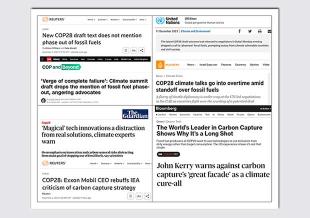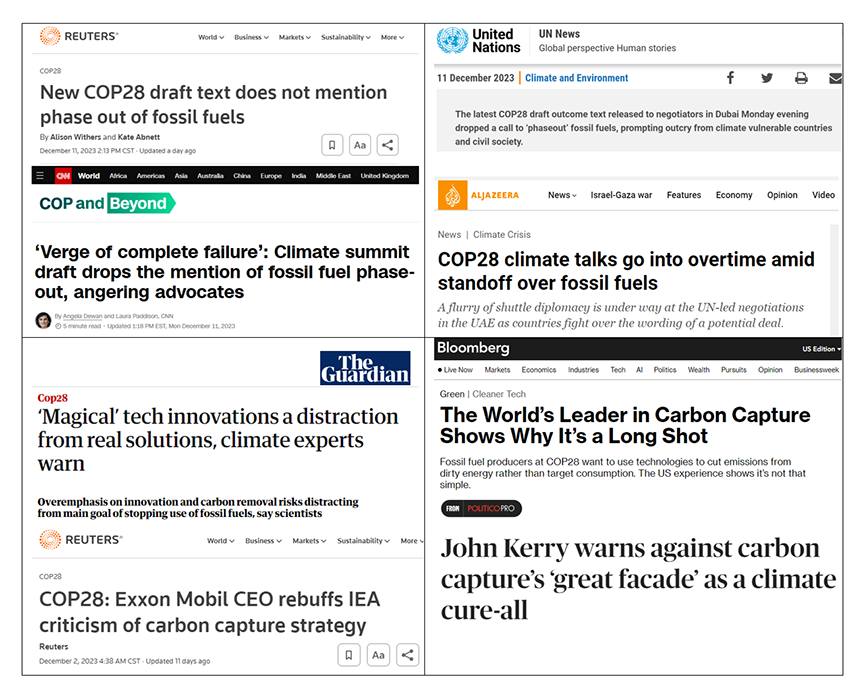News | Thought Leadership
Climate Action: COP28 and Carbon Capture


As a transitional solution, carbon capture plays a critical role in reducing CO2 emissions while the global economy shifts to more sustainable manufacturing and energy production methods. This week in our continuing series showcasing how engineers and scientists can play a key role in addressing the short- and long-term challenges of climate change, Vice President Emily Kunkel of our Applied Science practice discusses the myths and facts around this decades-old method.
Held November 30 to December 12 in Dubai, the COP28 summit gathered representatives from nearly 200 countries to discuss how to fight climate change. Coming from small island countries to large state-owned oil and gas companies, representatives in attendance lent their voices to the drafting of the deal, which was finalized in overtime.
While the biggest headlines emerging from COP28 were about the removal of terminology around phasing out fossil fuels, one other hot topic has risen to the surface: carbon capture. Is mitigating CO2 emissions from fossil fuels via carbon capture a viable option for fighting climate change?
From the headlines, carbon capture is assumed to be a “magical” technology that is a “long shot” and a “great façade” to climate change progress. The concern many people have is that the use of carbon capture technology will not actually reduce CO2 worldwide emissions, but rather provide a crutch for fossil fuel companies to continue to operate as status-quo. So, let’s look at some of the myths and facts around carbon capture.
Myth: Carbon capture is a façade to progress. It’s actually a very useful technology that can remove >90% of CO2 from sources—CO2 that could have risen into the atmosphere is instead captured and sequestered. Carbon capture is also one of the only pathways to decarbonize certain industries where chemistry dictates that electrification will not fully reduce CO2 emissions, such as cement production. Not to mention, direct air carbon capture is an important technology to remove CO2 already in the atmosphere. It’s short-sighted to call all carbon capture applications a façade when, realistically, it will be the most viable way to decarbonize a variety of industrial sectors.
Fact: Carbon capture uses a lot of energy and is expensive. Depending on the application, this is indeed true, which is why tax credits have such a critical role in financing these projects. Capturing carbon from gases can be very energy intensive and cost a lot on a $/ton-of-CO2 basis. Cost is exacerbated if we can’t sell or use the CO2 for beneficial purposes. This is why we need financial incentives to get the next round of projects to fruition. We have already seen step-change improvements in energy efficiency and cost reduction as more R&D goes into new applications. Carbon capture could see even further cost reductions with large-scale adoption, just like renewable technology has—look how efficient solar panel production is and how cheap they’ve become! Carbon capture could be next.
Myth: Carbon capture is magic. It’s actually a 60-year-old science! Amines have been used to capture CO2 and other acid gases from natural gas processing systems (called gas sweetening), and carbon capture has expanded to a variety of other industries and applications. It has even been applied at power plants to capture CO2 for food and beverage uses since the early 1990s. No magic here, just lots of chemical engineers working their “magic” for generations.
Fact: Carbon capture is only one of many tools. While it is a very useful technology that can be applied where CO2 is in gas phase, there are many applications for which electrification is a better option. Also, there are major limitations to where carbon capture can be applied based on what we can do with CO2 after it is captured and compressed. Sequestration is possible on the giga-scale but is regionally specific based on geology. Giga-scale utilization breakthroughs are still on the verge of developments as many industries are trying to find commercial ways to use CO2 as feedstock, such as in sustainable aviation fuels. We could use the help of more magicians and alchemists, after all…
Myth: Carbon capture is a long shot. The technology has already been proven at 240 MWe scale on a coal-fired power plant in Texas. It successfully operated from 2016−2019 and met criteria set forth by the US Department of Energy. However, no new large-scale systems have been commissioned since then in the US due to the lack of requirements to implement it and limited use of CO2 emissions regulation, especially in the US. While there haven’t been many full-scale applications of carbon capture to date, power utilities and heavy industrial companies have invested millions of dollars into developing the technology further to apply it at even large scales in the near future. This is helped by the recent announcement from the US DOE to fund $890M between three large-scale projects.
Fact: Carbon capture has a slow time to full-scale roll out. It’s much easier to pull the trigger on carbon capture when you can get pipelines and wells permitted quickly. For the amount of CO2 capture we are talking about (hundreds of millions of tons per year in the US alone), we would need more CO2 pipelines (we already have thousands of miles of CO2 pipeline crisscrossing certain regions) and significantly more Class VI sequestration wells than are currently permitted. This is a call to action for regulatory support to facilitate quicker roll out.
Overall, carbon capture is a relatively advanced technology that can be a viable way to mitigate emissions from CO2-producing sources and even from the atmosphere. Fossil fuels, petrochemicals and other carbon-based feedstocks are, whether we like it or not, the backbone of the world economy and imperative to many industries. Changing the way we make steel, cement, power, chemicals, etc. has begun and will take generations. Thus, in the interim, carbon capture could operate as a bridge technology to help abate CO2 emissions from fossil fuel sources while manufacturing and energy- production processes transition to completely new means and methods.
For now, we need to reduce the amount of CO2 emitted into the atmosphere, and carbon capture can be applied to just about all of these industries to help mitigate CO2 by more than 90%. It is just one of the many tools in our toolbox to fight climate change. I’m all for finding ways to increase the number of tools in our toolbox, so why toss out a handy one?
Climate change is one of the biggest challenges facing our society. And because it affects everyone, it demands our creativity, passion and collaboration to build a better, more enduring world. See how Thornton Tomasetti is one of the only firms with the expertise to help you think holistically about a range of steps to address climate change.

